BMSW4003 - Virtual Learning Environment Impact: Research Report
VerifiedAdded on 2023/06/07
|20
|2450
|148
Report
AI Summary
This report investigates the impact of Virtual Learning Environments (VLE) on educational institutions, particularly in the context of the shift to online learning accelerated by the COVID-19 pandemic. It explores the benefits and challenges of VLEs, including their role in facilitating remote learning, providing access to educational resources, and tracking student progress. The research employs both primary and secondary research methods, including a survey to gather quantitative and qualitative data on student experiences with VLEs. The findings indicate that while students are generally interested in virtual learning, challenges exist regarding technology access, engagement, and the need for improved online teaching platforms. The report concludes that VLEs are increasingly important in education but require ongoing development and support to address identified weaknesses and maximize their effectiveness. Desklib provides students access to similar solved assignments and research reports.
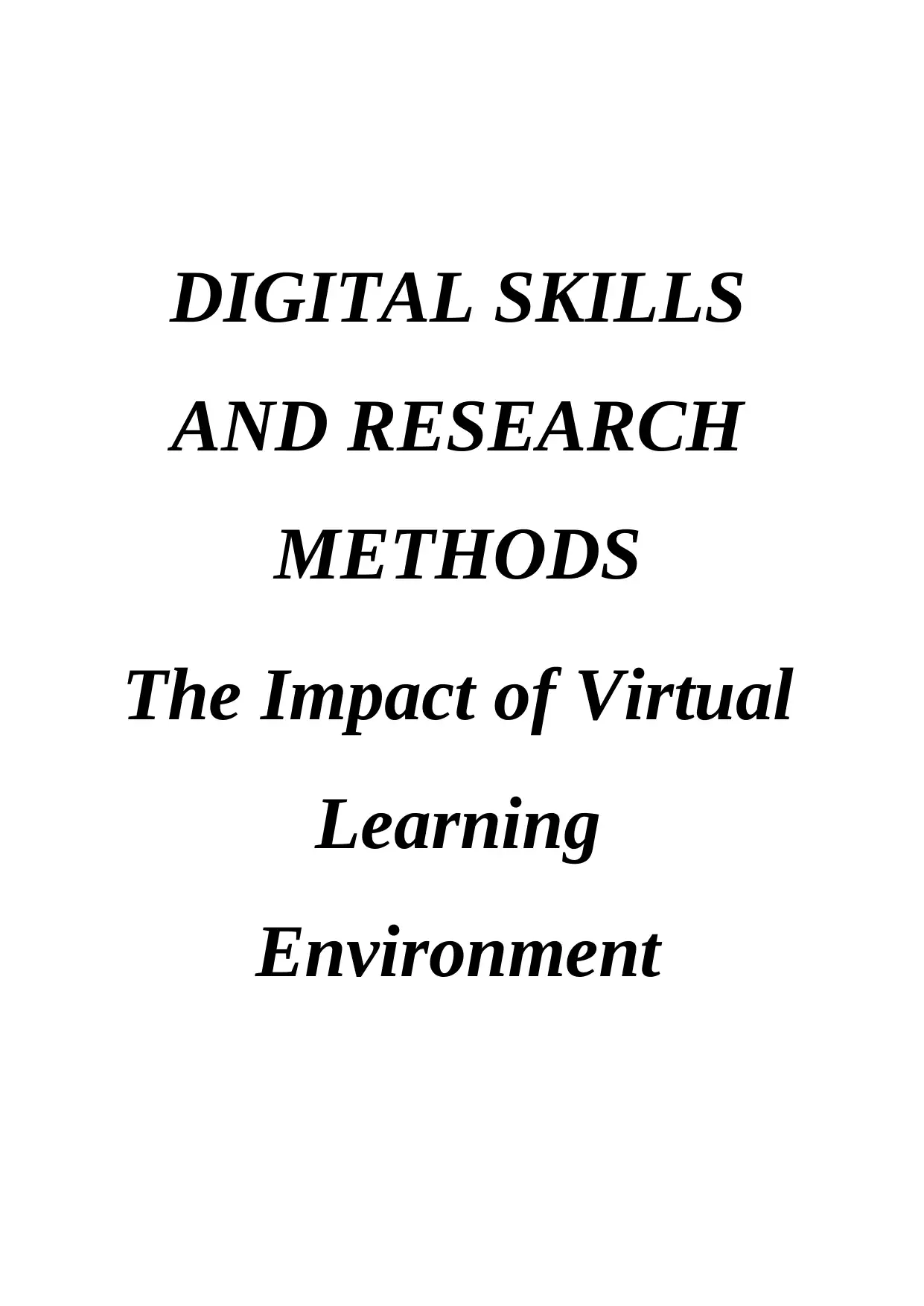
DIGITAL SKILLS
AND RESEARCH
METHODS
The Impact of Virtual
Learning
Environment
AND RESEARCH
METHODS
The Impact of Virtual
Learning
Environment
Paraphrase This Document
Need a fresh take? Get an instant paraphrase of this document with our AI Paraphraser
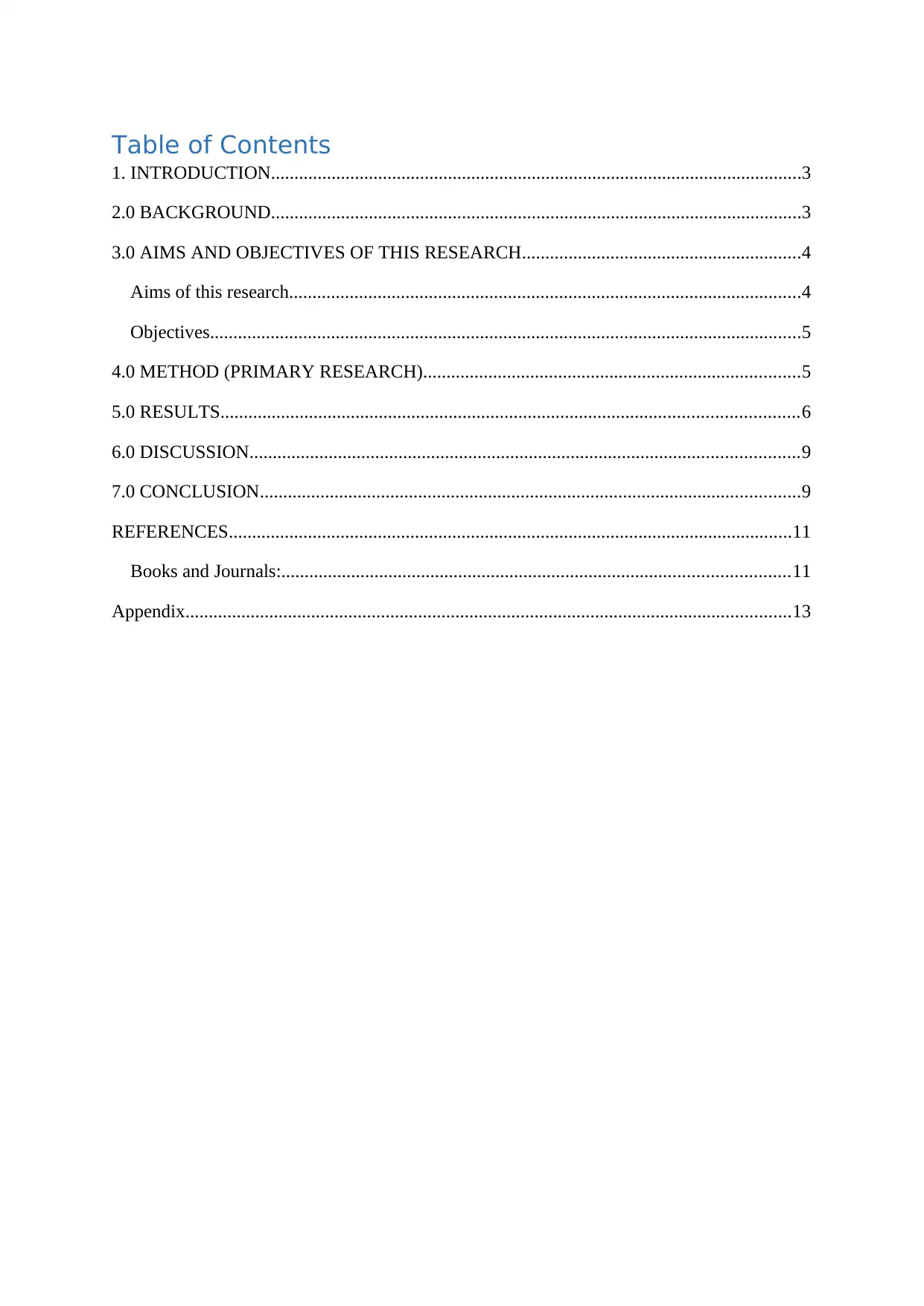
Table of Contents
1. INTRODUCTION..................................................................................................................3
2.0 BACKGROUND..................................................................................................................3
3.0 AIMS AND OBJECTIVES OF THIS RESEARCH............................................................4
Aims of this research..............................................................................................................4
Objectives...............................................................................................................................5
4.0 METHOD (PRIMARY RESEARCH).................................................................................5
5.0 RESULTS............................................................................................................................6
6.0 DISCUSSION......................................................................................................................9
7.0 CONCLUSION....................................................................................................................9
REFERENCES.........................................................................................................................11
Books and Journals:.............................................................................................................11
Appendix..................................................................................................................................13
1. INTRODUCTION..................................................................................................................3
2.0 BACKGROUND..................................................................................................................3
3.0 AIMS AND OBJECTIVES OF THIS RESEARCH............................................................4
Aims of this research..............................................................................................................4
Objectives...............................................................................................................................5
4.0 METHOD (PRIMARY RESEARCH).................................................................................5
5.0 RESULTS............................................................................................................................6
6.0 DISCUSSION......................................................................................................................9
7.0 CONCLUSION....................................................................................................................9
REFERENCES.........................................................................................................................11
Books and Journals:.............................................................................................................11
Appendix..................................................................................................................................13
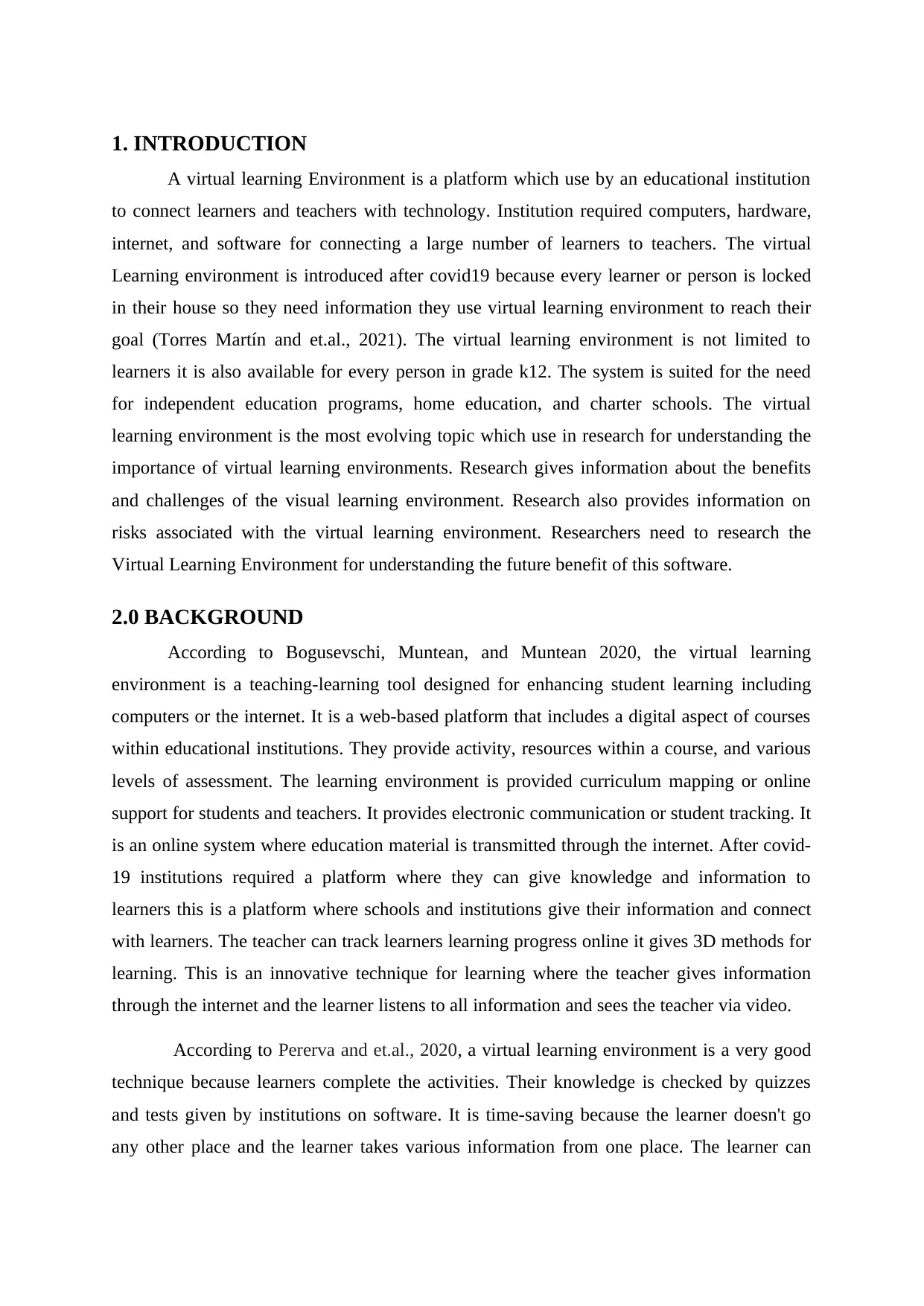
1. INTRODUCTION
A virtual learning Environment is a platform which use by an educational institution
to connect learners and teachers with technology. Institution required computers, hardware,
internet, and software for connecting a large number of learners to teachers. The virtual
Learning environment is introduced after covid19 because every learner or person is locked
in their house so they need information they use virtual learning environment to reach their
goal (Torres Martín and et.al., 2021). The virtual learning environment is not limited to
learners it is also available for every person in grade k12. The system is suited for the need
for independent education programs, home education, and charter schools. The virtual
learning environment is the most evolving topic which use in research for understanding the
importance of virtual learning environments. Research gives information about the benefits
and challenges of the visual learning environment. Research also provides information on
risks associated with the virtual learning environment. Researchers need to research the
Virtual Learning Environment for understanding the future benefit of this software.
2.0 BACKGROUND
According to Bogusevschi, Muntean, and Muntean 2020, the virtual learning
environment is a teaching-learning tool designed for enhancing student learning including
computers or the internet. It is a web-based platform that includes a digital aspect of courses
within educational institutions. They provide activity, resources within a course, and various
levels of assessment. The learning environment is provided curriculum mapping or online
support for students and teachers. It provides electronic communication or student tracking. It
is an online system where education material is transmitted through the internet. After covid-
19 institutions required a platform where they can give knowledge and information to
learners this is a platform where schools and institutions give their information and connect
with learners. The teacher can track learners learning progress online it gives 3D methods for
learning. This is an innovative technique for learning where the teacher gives information
through the internet and the learner listens to all information and sees the teacher via video.
According to Pererva and et.al., 2020, a virtual learning environment is a very good
technique because learners complete the activities. Their knowledge is checked by quizzes
and tests given by institutions on software. It is time-saving because the learner doesn't go
any other place and the learner takes various information from one place. The learner can
A virtual learning Environment is a platform which use by an educational institution
to connect learners and teachers with technology. Institution required computers, hardware,
internet, and software for connecting a large number of learners to teachers. The virtual
Learning environment is introduced after covid19 because every learner or person is locked
in their house so they need information they use virtual learning environment to reach their
goal (Torres Martín and et.al., 2021). The virtual learning environment is not limited to
learners it is also available for every person in grade k12. The system is suited for the need
for independent education programs, home education, and charter schools. The virtual
learning environment is the most evolving topic which use in research for understanding the
importance of virtual learning environments. Research gives information about the benefits
and challenges of the visual learning environment. Research also provides information on
risks associated with the virtual learning environment. Researchers need to research the
Virtual Learning Environment for understanding the future benefit of this software.
2.0 BACKGROUND
According to Bogusevschi, Muntean, and Muntean 2020, the virtual learning
environment is a teaching-learning tool designed for enhancing student learning including
computers or the internet. It is a web-based platform that includes a digital aspect of courses
within educational institutions. They provide activity, resources within a course, and various
levels of assessment. The learning environment is provided curriculum mapping or online
support for students and teachers. It provides electronic communication or student tracking. It
is an online system where education material is transmitted through the internet. After covid-
19 institutions required a platform where they can give knowledge and information to
learners this is a platform where schools and institutions give their information and connect
with learners. The teacher can track learners learning progress online it gives 3D methods for
learning. This is an innovative technique for learning where the teacher gives information
through the internet and the learner listens to all information and sees the teacher via video.
According to Pererva and et.al., 2020, a virtual learning environment is a very good
technique because learners complete the activities. Their knowledge is checked by quizzes
and tests given by institutions on software. It is time-saving because the learner doesn't go
any other place and the learner takes various information from one place. The learner can
⊘ This is a preview!⊘
Do you want full access?
Subscribe today to unlock all pages.

Trusted by 1+ million students worldwide
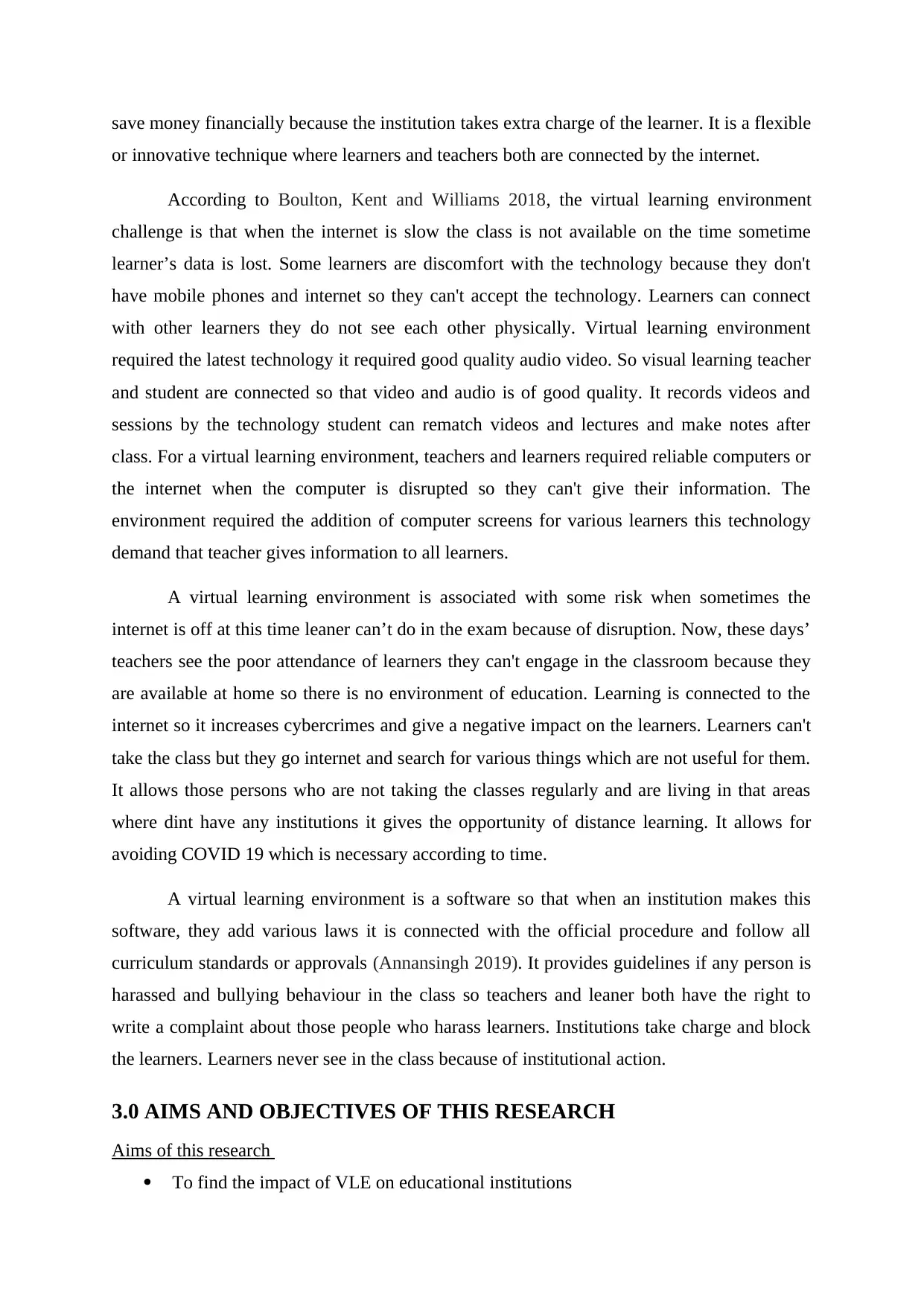
save money financially because the institution takes extra charge of the learner. It is a flexible
or innovative technique where learners and teachers both are connected by the internet.
According to Boulton, Kent and Williams 2018, the virtual learning environment
challenge is that when the internet is slow the class is not available on the time sometime
learner’s data is lost. Some learners are discomfort with the technology because they don't
have mobile phones and internet so they can't accept the technology. Learners can connect
with other learners they do not see each other physically. Virtual learning environment
required the latest technology it required good quality audio video. So visual learning teacher
and student are connected so that video and audio is of good quality. It records videos and
sessions by the technology student can rematch videos and lectures and make notes after
class. For a virtual learning environment, teachers and learners required reliable computers or
the internet when the computer is disrupted so they can't give their information. The
environment required the addition of computer screens for various learners this technology
demand that teacher gives information to all learners.
A virtual learning environment is associated with some risk when sometimes the
internet is off at this time leaner can’t do in the exam because of disruption. Now, these days’
teachers see the poor attendance of learners they can't engage in the classroom because they
are available at home so there is no environment of education. Learning is connected to the
internet so it increases cybercrimes and give a negative impact on the learners. Learners can't
take the class but they go internet and search for various things which are not useful for them.
It allows those persons who are not taking the classes regularly and are living in that areas
where dint have any institutions it gives the opportunity of distance learning. It allows for
avoiding COVID 19 which is necessary according to time.
A virtual learning environment is a software so that when an institution makes this
software, they add various laws it is connected with the official procedure and follow all
curriculum standards or approvals (Annansingh 2019). It provides guidelines if any person is
harassed and bullying behaviour in the class so teachers and leaner both have the right to
write a complaint about those people who harass learners. Institutions take charge and block
the learners. Learners never see in the class because of institutional action.
3.0 AIMS AND OBJECTIVES OF THIS RESEARCH
Aims of this research
To find the impact of VLE on educational institutions
or innovative technique where learners and teachers both are connected by the internet.
According to Boulton, Kent and Williams 2018, the virtual learning environment
challenge is that when the internet is slow the class is not available on the time sometime
learner’s data is lost. Some learners are discomfort with the technology because they don't
have mobile phones and internet so they can't accept the technology. Learners can connect
with other learners they do not see each other physically. Virtual learning environment
required the latest technology it required good quality audio video. So visual learning teacher
and student are connected so that video and audio is of good quality. It records videos and
sessions by the technology student can rematch videos and lectures and make notes after
class. For a virtual learning environment, teachers and learners required reliable computers or
the internet when the computer is disrupted so they can't give their information. The
environment required the addition of computer screens for various learners this technology
demand that teacher gives information to all learners.
A virtual learning environment is associated with some risk when sometimes the
internet is off at this time leaner can’t do in the exam because of disruption. Now, these days’
teachers see the poor attendance of learners they can't engage in the classroom because they
are available at home so there is no environment of education. Learning is connected to the
internet so it increases cybercrimes and give a negative impact on the learners. Learners can't
take the class but they go internet and search for various things which are not useful for them.
It allows those persons who are not taking the classes regularly and are living in that areas
where dint have any institutions it gives the opportunity of distance learning. It allows for
avoiding COVID 19 which is necessary according to time.
A virtual learning environment is a software so that when an institution makes this
software, they add various laws it is connected with the official procedure and follow all
curriculum standards or approvals (Annansingh 2019). It provides guidelines if any person is
harassed and bullying behaviour in the class so teachers and leaner both have the right to
write a complaint about those people who harass learners. Institutions take charge and block
the learners. Learners never see in the class because of institutional action.
3.0 AIMS AND OBJECTIVES OF THIS RESEARCH
Aims of this research
To find the impact of VLE on educational institutions
Paraphrase This Document
Need a fresh take? Get an instant paraphrase of this document with our AI Paraphraser
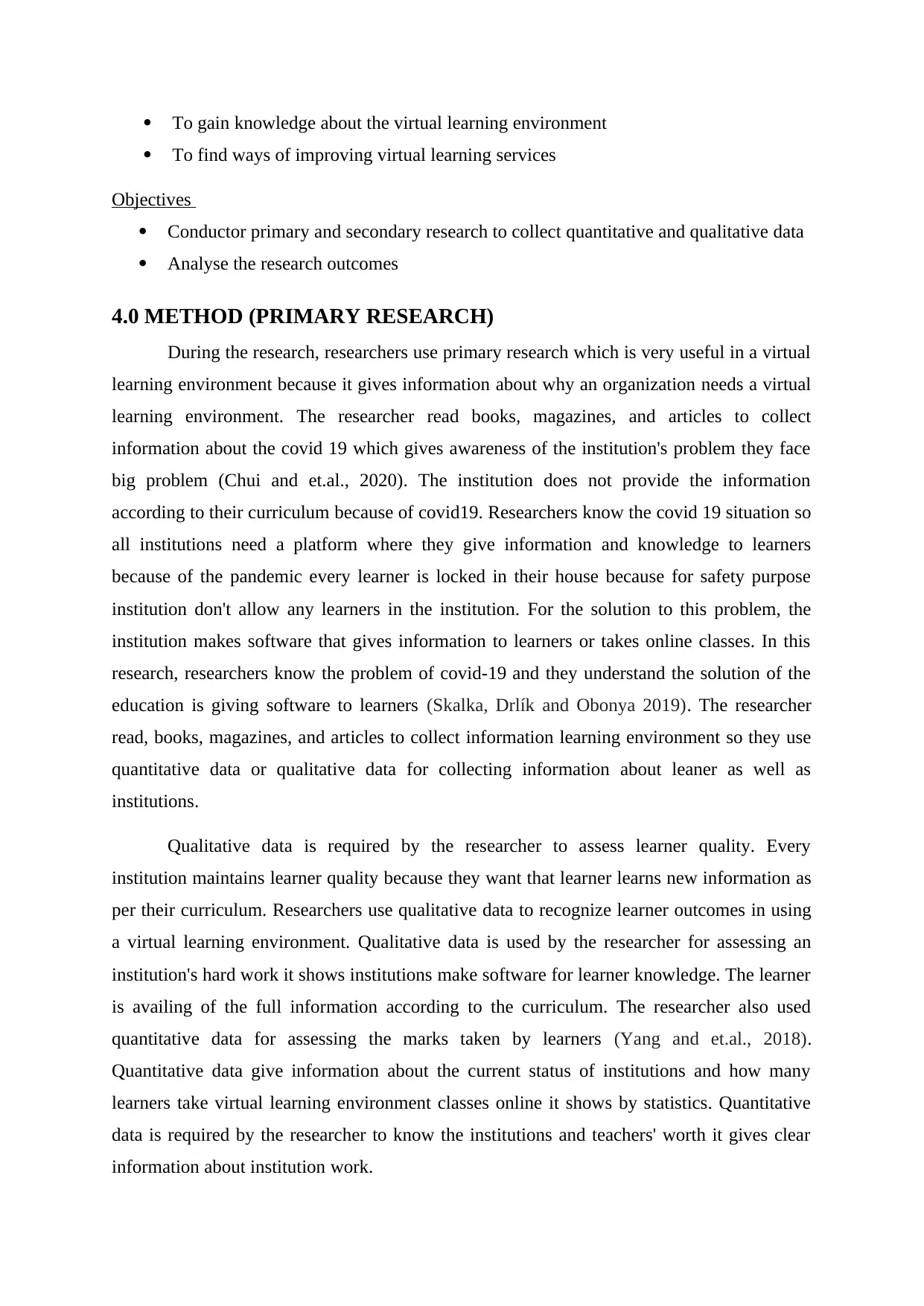
To gain knowledge about the virtual learning environment
To find ways of improving virtual learning services
Objectives
Conductor primary and secondary research to collect quantitative and qualitative data
Analyse the research outcomes
4.0 METHOD (PRIMARY RESEARCH)
During the research, researchers use primary research which is very useful in a virtual
learning environment because it gives information about why an organization needs a virtual
learning environment. The researcher read books, magazines, and articles to collect
information about the covid 19 which gives awareness of the institution's problem they face
big problem (Chui and et.al., 2020). The institution does not provide the information
according to their curriculum because of covid19. Researchers know the covid 19 situation so
all institutions need a platform where they give information and knowledge to learners
because of the pandemic every learner is locked in their house because for safety purpose
institution don't allow any learners in the institution. For the solution to this problem, the
institution makes software that gives information to learners or takes online classes. In this
research, researchers know the problem of covid-19 and they understand the solution of the
education is giving software to learners (Skalka, Drlík and Obonya 2019). The researcher
read, books, magazines, and articles to collect information learning environment so they use
quantitative data or qualitative data for collecting information about leaner as well as
institutions.
Qualitative data is required by the researcher to assess learner quality. Every
institution maintains learner quality because they want that learner learns new information as
per their curriculum. Researchers use qualitative data to recognize learner outcomes in using
a virtual learning environment. Qualitative data is used by the researcher for assessing an
institution's hard work it shows institutions make software for learner knowledge. The learner
is availing of the full information according to the curriculum. The researcher also used
quantitative data for assessing the marks taken by learners (Yang and et.al., 2018).
Quantitative data give information about the current status of institutions and how many
learners take virtual learning environment classes online it shows by statistics. Quantitative
data is required by the researcher to know the institutions and teachers' worth it gives clear
information about institution work.
To find ways of improving virtual learning services
Objectives
Conductor primary and secondary research to collect quantitative and qualitative data
Analyse the research outcomes
4.0 METHOD (PRIMARY RESEARCH)
During the research, researchers use primary research which is very useful in a virtual
learning environment because it gives information about why an organization needs a virtual
learning environment. The researcher read books, magazines, and articles to collect
information about the covid 19 which gives awareness of the institution's problem they face
big problem (Chui and et.al., 2020). The institution does not provide the information
according to their curriculum because of covid19. Researchers know the covid 19 situation so
all institutions need a platform where they give information and knowledge to learners
because of the pandemic every learner is locked in their house because for safety purpose
institution don't allow any learners in the institution. For the solution to this problem, the
institution makes software that gives information to learners or takes online classes. In this
research, researchers know the problem of covid-19 and they understand the solution of the
education is giving software to learners (Skalka, Drlík and Obonya 2019). The researcher
read, books, magazines, and articles to collect information learning environment so they use
quantitative data or qualitative data for collecting information about leaner as well as
institutions.
Qualitative data is required by the researcher to assess learner quality. Every
institution maintains learner quality because they want that learner learns new information as
per their curriculum. Researchers use qualitative data to recognize learner outcomes in using
a virtual learning environment. Qualitative data is used by the researcher for assessing an
institution's hard work it shows institutions make software for learner knowledge. The learner
is availing of the full information according to the curriculum. The researcher also used
quantitative data for assessing the marks taken by learners (Yang and et.al., 2018).
Quantitative data give information about the current status of institutions and how many
learners take virtual learning environment classes online it shows by statistics. Quantitative
data is required by the researcher to know the institutions and teachers' worth it gives clear
information about institution work.
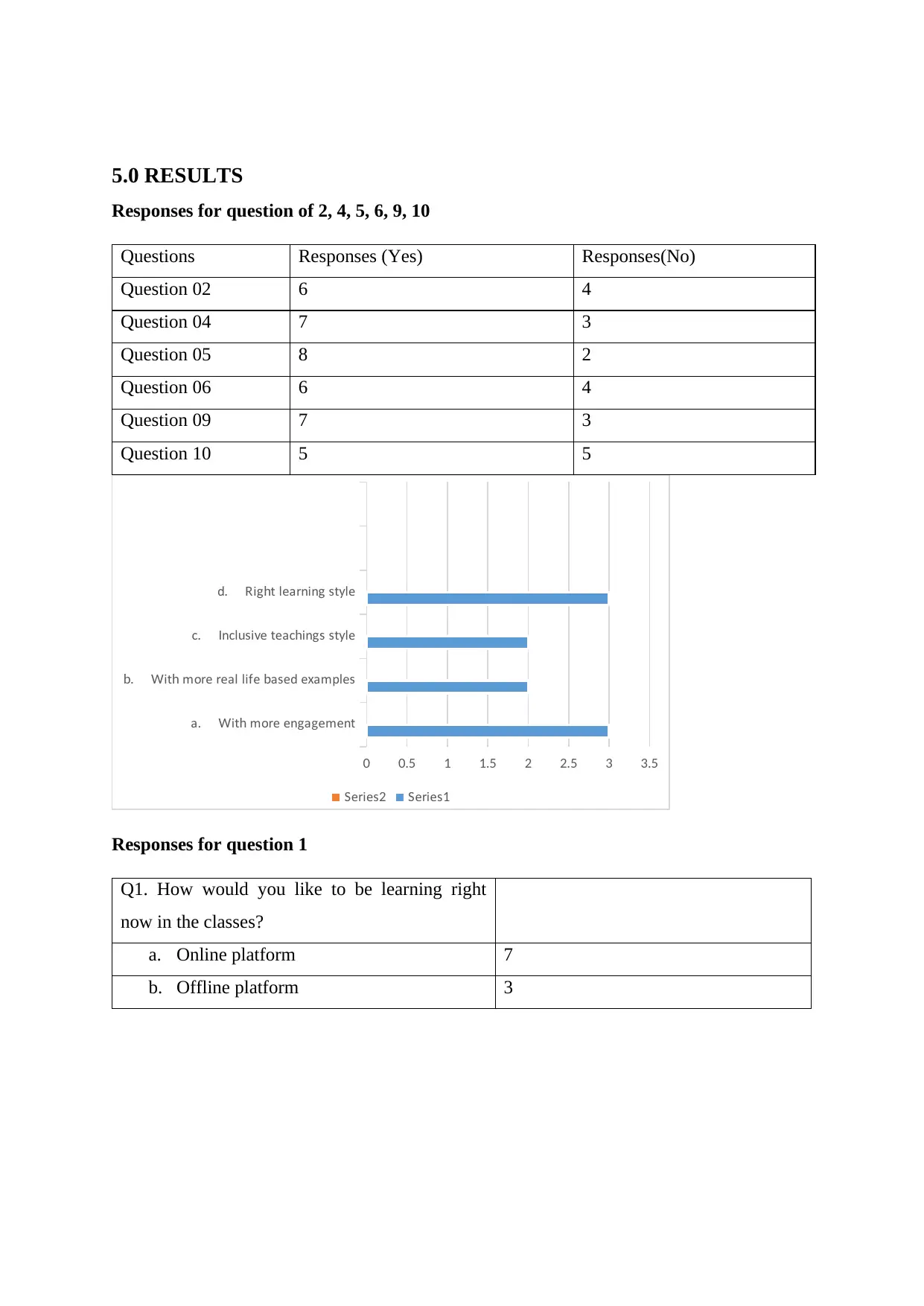
5.0 RESULTS
Responses for question of 2, 4, 5, 6, 9, 10
Questions Responses (Yes) Responses(No)
Question 02 6 4
Question 04 7 3
Question 05 8 2
Question 06 6 4
Question 09 7 3
Question 10 5 5
a it more en a ement. W h g g
it more real li e a ed e ampleb. W h f b s x s
c ncl i e teac in t le. I us v h gs s y
d i t learnin t le. R gh g s y
0 0.5 1 1.5 2 2.5 3 3.5
erieS s2 erieS s1
Responses for question 1
Q1. How would you like to be learning right
now in the classes?
a. Online platform 7
b. Offline platform 3
Responses for question of 2, 4, 5, 6, 9, 10
Questions Responses (Yes) Responses(No)
Question 02 6 4
Question 04 7 3
Question 05 8 2
Question 06 6 4
Question 09 7 3
Question 10 5 5
a it more en a ement. W h g g
it more real li e a ed e ampleb. W h f b s x s
c ncl i e teac in t le. I us v h gs s y
d i t learnin t le. R gh g s y
0 0.5 1 1.5 2 2.5 3 3.5
erieS s2 erieS s1
Responses for question 1
Q1. How would you like to be learning right
now in the classes?
a. Online platform 7
b. Offline platform 3
⊘ This is a preview!⊘
Do you want full access?
Subscribe today to unlock all pages.

Trusted by 1+ million students worldwide
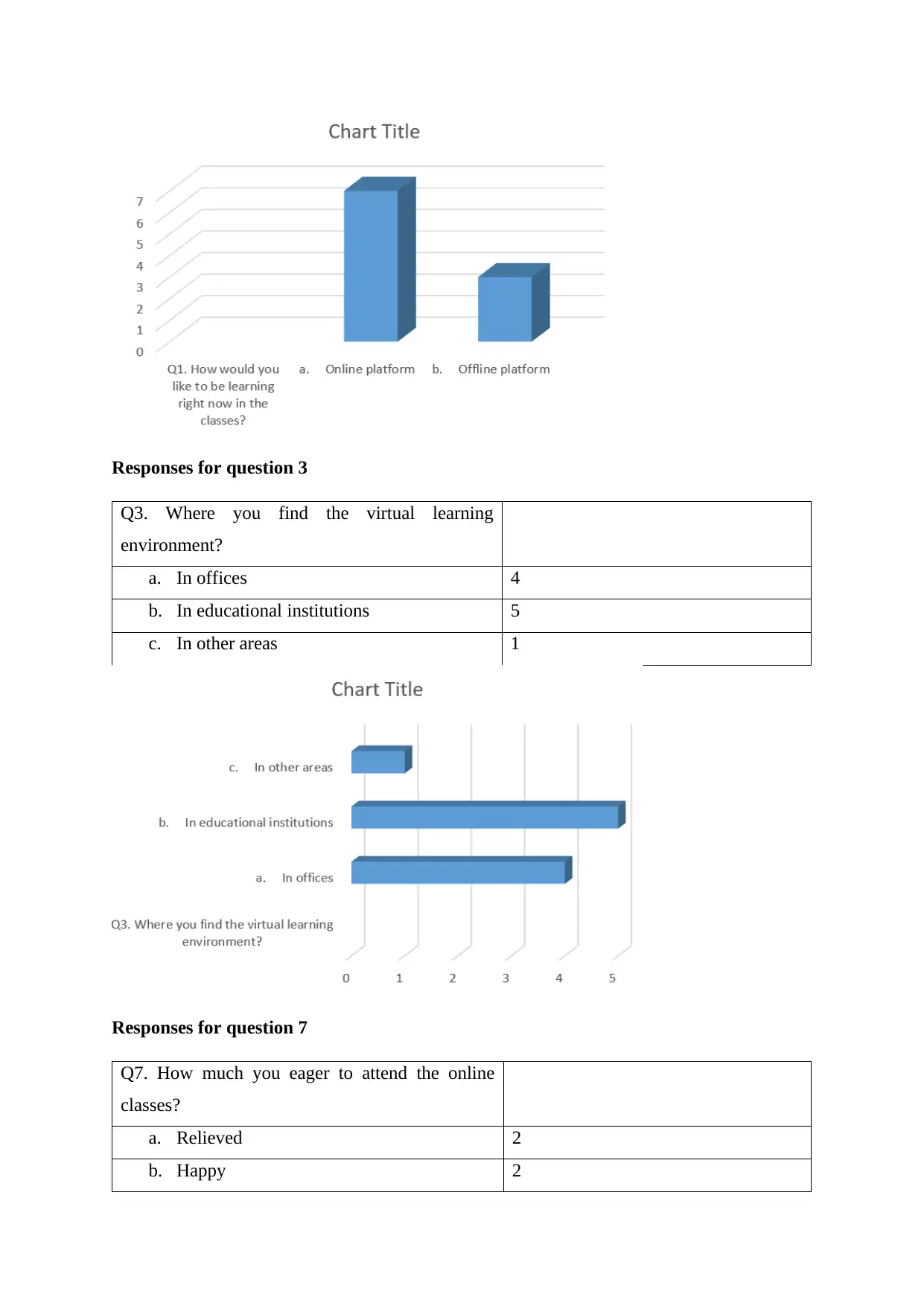
Responses for question 3
Q3. Where you find the virtual learning
environment?
a. In offices 4
b. In educational institutions 5
c. In other areas 1
Responses for question 7
Q7. How much you eager to attend the online
classes?
a. Relieved 2
b. Happy 2
Q3. Where you find the virtual learning
environment?
a. In offices 4
b. In educational institutions 5
c. In other areas 1
Responses for question 7
Q7. How much you eager to attend the online
classes?
a. Relieved 2
b. Happy 2
Paraphrase This Document
Need a fresh take? Get an instant paraphrase of this document with our AI Paraphraser
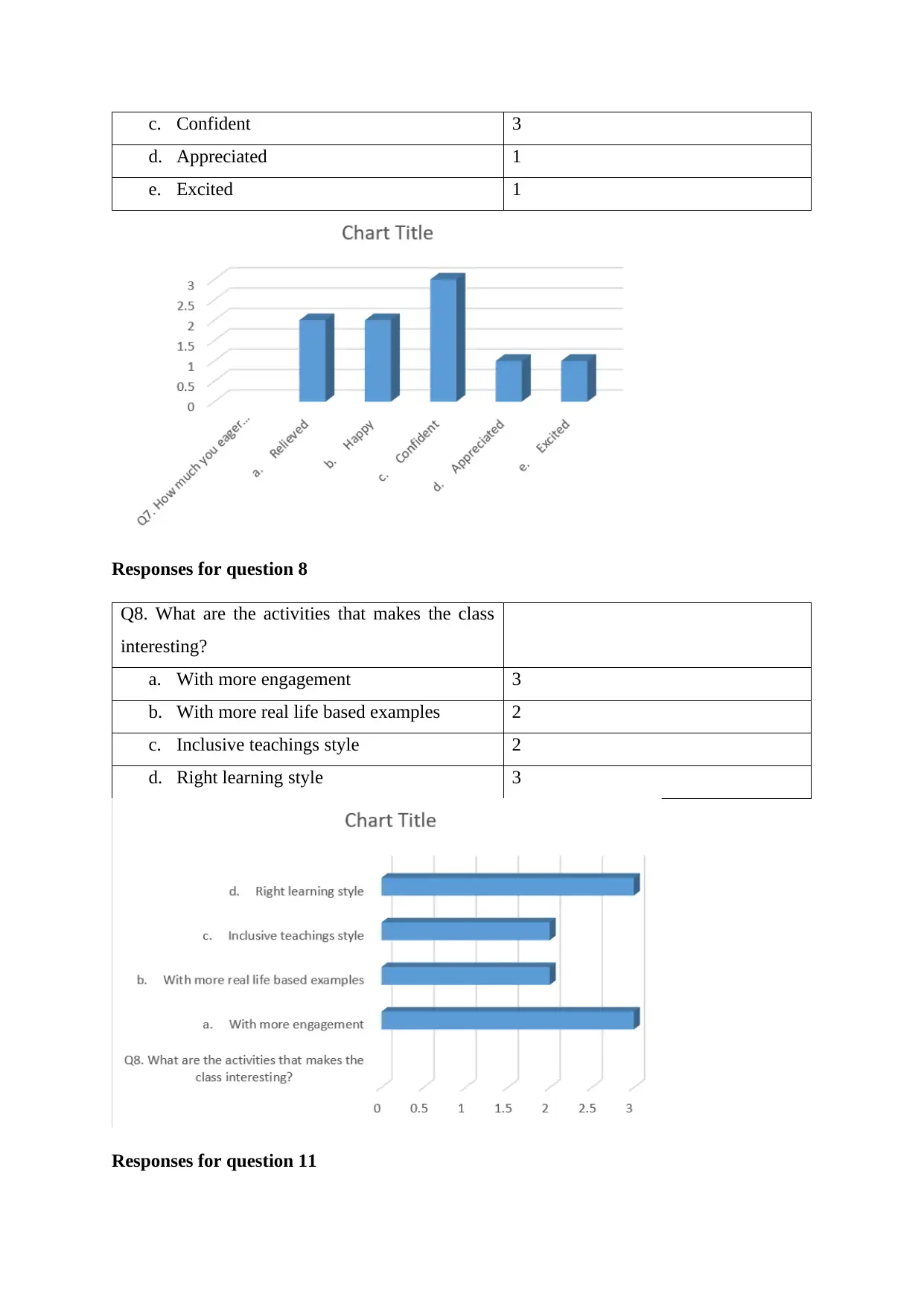
c. Confident 3
d. Appreciated 1
e. Excited 1
Responses for question 8
Q8. What are the activities that makes the class
interesting?
a. With more engagement 3
b. With more real life based examples 2
c. Inclusive teachings style 2
d. Right learning style 3
Responses for question 11
d. Appreciated 1
e. Excited 1
Responses for question 8
Q8. What are the activities that makes the class
interesting?
a. With more engagement 3
b. With more real life based examples 2
c. Inclusive teachings style 2
d. Right learning style 3
Responses for question 11
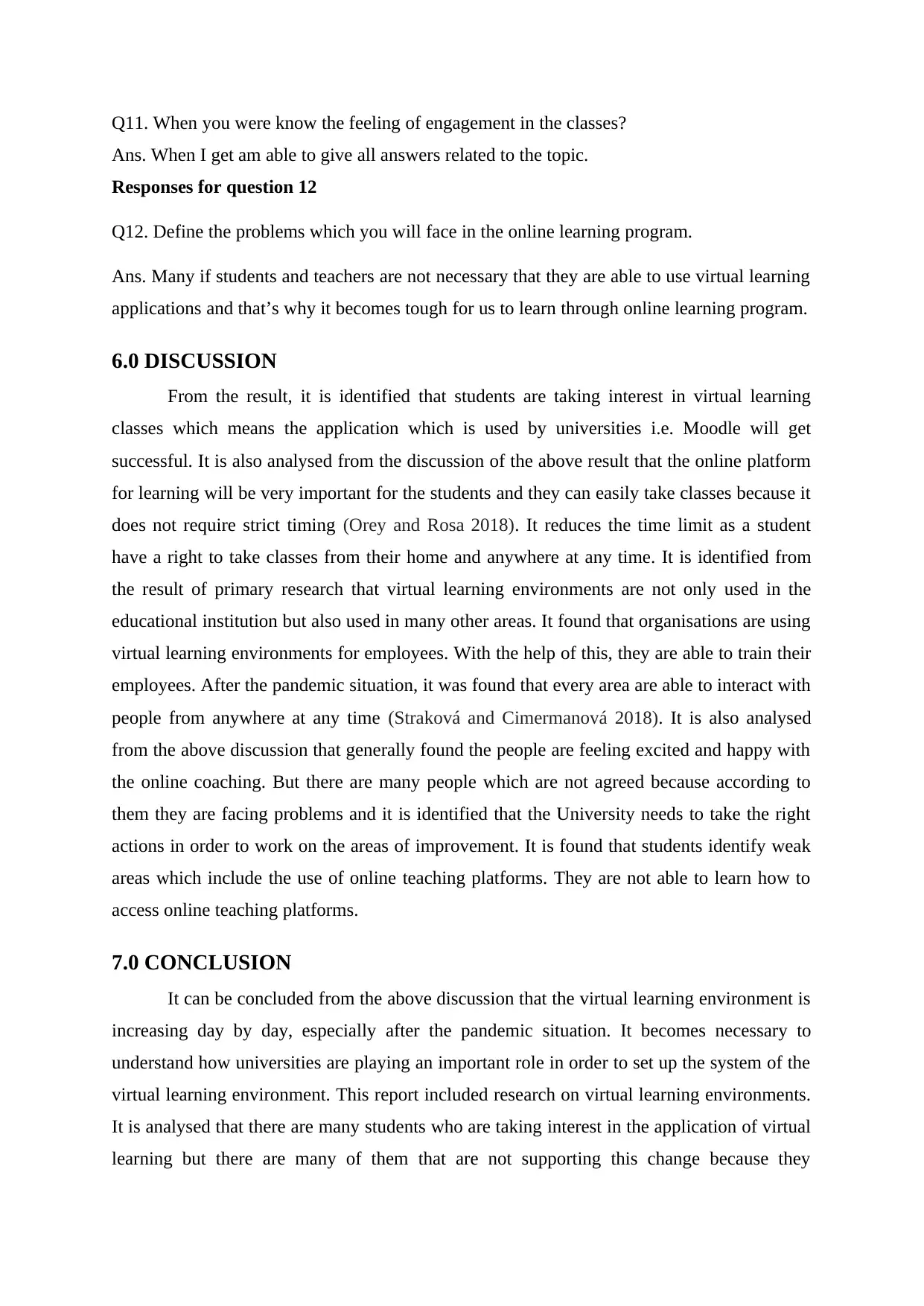
Q11. When you were know the feeling of engagement in the classes?
Ans. When I get am able to give all answers related to the topic.
Responses for question 12
Q12. Define the problems which you will face in the online learning program.
Ans. Many if students and teachers are not necessary that they are able to use virtual learning
applications and that’s why it becomes tough for us to learn through online learning program.
6.0 DISCUSSION
From the result, it is identified that students are taking interest in virtual learning
classes which means the application which is used by universities i.e. Moodle will get
successful. It is also analysed from the discussion of the above result that the online platform
for learning will be very important for the students and they can easily take classes because it
does not require strict timing (Orey and Rosa 2018). It reduces the time limit as a student
have a right to take classes from their home and anywhere at any time. It is identified from
the result of primary research that virtual learning environments are not only used in the
educational institution but also used in many other areas. It found that organisations are using
virtual learning environments for employees. With the help of this, they are able to train their
employees. After the pandemic situation, it was found that every area are able to interact with
people from anywhere at any time (Straková and Cimermanová 2018). It is also analysed
from the above discussion that generally found the people are feeling excited and happy with
the online coaching. But there are many people which are not agreed because according to
them they are facing problems and it is identified that the University needs to take the right
actions in order to work on the areas of improvement. It is found that students identify weak
areas which include the use of online teaching platforms. They are not able to learn how to
access online teaching platforms.
7.0 CONCLUSION
It can be concluded from the above discussion that the virtual learning environment is
increasing day by day, especially after the pandemic situation. It becomes necessary to
understand how universities are playing an important role in order to set up the system of the
virtual learning environment. This report included research on virtual learning environments.
It is analysed that there are many students who are taking interest in the application of virtual
learning but there are many of them that are not supporting this change because they
Ans. When I get am able to give all answers related to the topic.
Responses for question 12
Q12. Define the problems which you will face in the online learning program.
Ans. Many if students and teachers are not necessary that they are able to use virtual learning
applications and that’s why it becomes tough for us to learn through online learning program.
6.0 DISCUSSION
From the result, it is identified that students are taking interest in virtual learning
classes which means the application which is used by universities i.e. Moodle will get
successful. It is also analysed from the discussion of the above result that the online platform
for learning will be very important for the students and they can easily take classes because it
does not require strict timing (Orey and Rosa 2018). It reduces the time limit as a student
have a right to take classes from their home and anywhere at any time. It is identified from
the result of primary research that virtual learning environments are not only used in the
educational institution but also used in many other areas. It found that organisations are using
virtual learning environments for employees. With the help of this, they are able to train their
employees. After the pandemic situation, it was found that every area are able to interact with
people from anywhere at any time (Straková and Cimermanová 2018). It is also analysed
from the above discussion that generally found the people are feeling excited and happy with
the online coaching. But there are many people which are not agreed because according to
them they are facing problems and it is identified that the University needs to take the right
actions in order to work on the areas of improvement. It is found that students identify weak
areas which include the use of online teaching platforms. They are not able to learn how to
access online teaching platforms.
7.0 CONCLUSION
It can be concluded from the above discussion that the virtual learning environment is
increasing day by day, especially after the pandemic situation. It becomes necessary to
understand how universities are playing an important role in order to set up the system of the
virtual learning environment. This report included research on virtual learning environments.
It is analysed that there are many students who are taking interest in the application of virtual
learning but there are many of them that are not supporting this change because they
⊘ This is a preview!⊘
Do you want full access?
Subscribe today to unlock all pages.

Trusted by 1+ million students worldwide

understand that it has many weak areas and the University needs to work on them. They
understood that it becomes necessary for the university to take the right actions in order to
make a success of virtual learning environment.
understood that it becomes necessary for the university to take the right actions in order to
make a success of virtual learning environment.
Paraphrase This Document
Need a fresh take? Get an instant paraphrase of this document with our AI Paraphraser
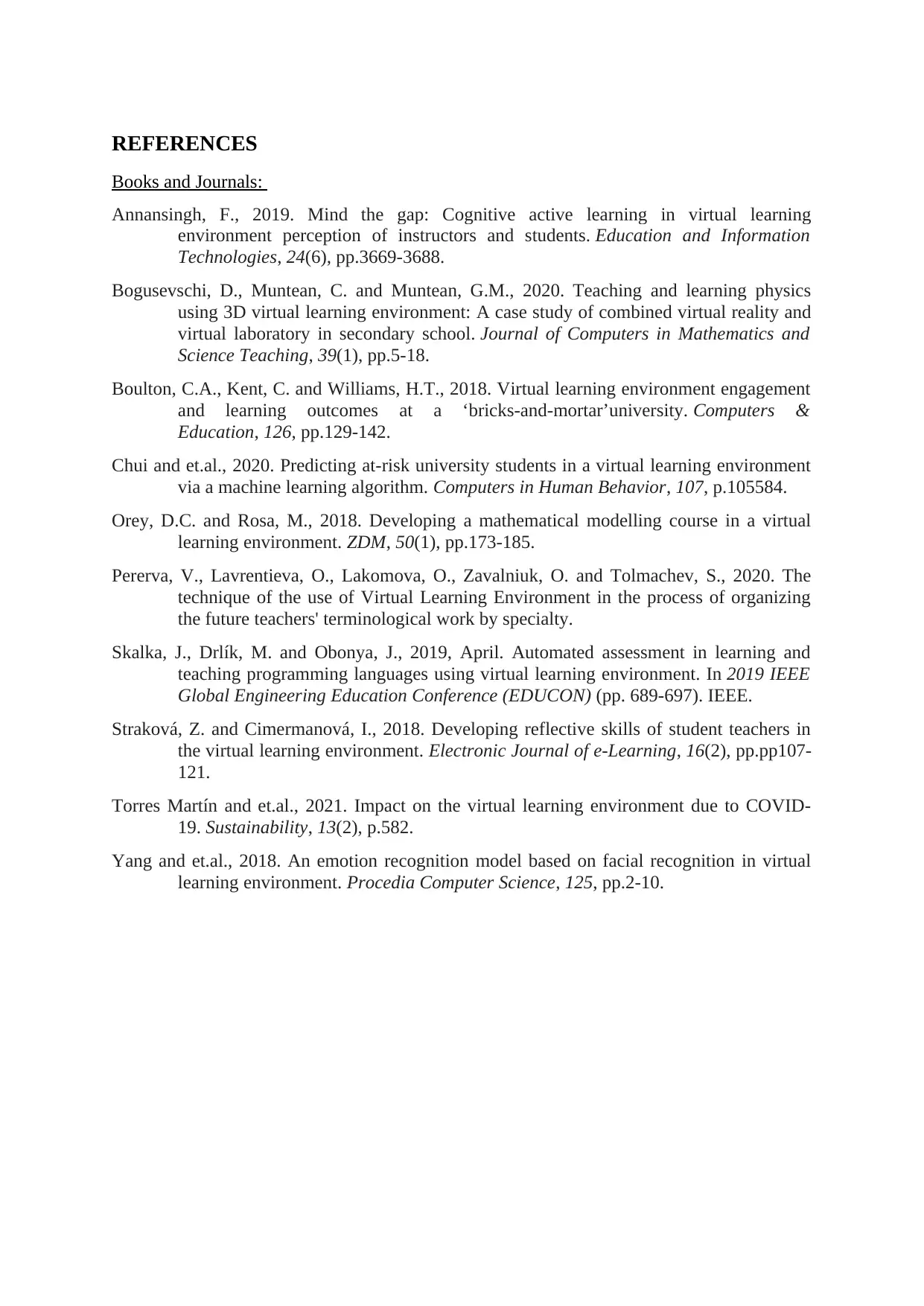
REFERENCES
Books and Journals:
Annansingh, F., 2019. Mind the gap: Cognitive active learning in virtual learning
environment perception of instructors and students. Education and Information
Technologies, 24(6), pp.3669-3688.
Bogusevschi, D., Muntean, C. and Muntean, G.M., 2020. Teaching and learning physics
using 3D virtual learning environment: A case study of combined virtual reality and
virtual laboratory in secondary school. Journal of Computers in Mathematics and
Science Teaching, 39(1), pp.5-18.
Boulton, C.A., Kent, C. and Williams, H.T., 2018. Virtual learning environment engagement
and learning outcomes at a ‘bricks-and-mortar’university. Computers &
Education, 126, pp.129-142.
Chui and et.al., 2020. Predicting at-risk university students in a virtual learning environment
via a machine learning algorithm. Computers in Human Behavior, 107, p.105584.
Orey, D.C. and Rosa, M., 2018. Developing a mathematical modelling course in a virtual
learning environment. ZDM, 50(1), pp.173-185.
Pererva, V., Lavrentieva, O., Lakomova, O., Zavalniuk, O. and Tolmachev, S., 2020. The
technique of the use of Virtual Learning Environment in the process of organizing
the future teachers' terminological work by specialty.
Skalka, J., Drlík, M. and Obonya, J., 2019, April. Automated assessment in learning and
teaching programming languages using virtual learning environment. In 2019 IEEE
Global Engineering Education Conference (EDUCON) (pp. 689-697). IEEE.
Straková, Z. and Cimermanová, I., 2018. Developing reflective skills of student teachers in
the virtual learning environment. Electronic Journal of e-Learning, 16(2), pp.pp107-
121.
Torres Martín and et.al., 2021. Impact on the virtual learning environment due to COVID-
19. Sustainability, 13(2), p.582.
Yang and et.al., 2018. An emotion recognition model based on facial recognition in virtual
learning environment. Procedia Computer Science, 125, pp.2-10.
Books and Journals:
Annansingh, F., 2019. Mind the gap: Cognitive active learning in virtual learning
environment perception of instructors and students. Education and Information
Technologies, 24(6), pp.3669-3688.
Bogusevschi, D., Muntean, C. and Muntean, G.M., 2020. Teaching and learning physics
using 3D virtual learning environment: A case study of combined virtual reality and
virtual laboratory in secondary school. Journal of Computers in Mathematics and
Science Teaching, 39(1), pp.5-18.
Boulton, C.A., Kent, C. and Williams, H.T., 2018. Virtual learning environment engagement
and learning outcomes at a ‘bricks-and-mortar’university. Computers &
Education, 126, pp.129-142.
Chui and et.al., 2020. Predicting at-risk university students in a virtual learning environment
via a machine learning algorithm. Computers in Human Behavior, 107, p.105584.
Orey, D.C. and Rosa, M., 2018. Developing a mathematical modelling course in a virtual
learning environment. ZDM, 50(1), pp.173-185.
Pererva, V., Lavrentieva, O., Lakomova, O., Zavalniuk, O. and Tolmachev, S., 2020. The
technique of the use of Virtual Learning Environment in the process of organizing
the future teachers' terminological work by specialty.
Skalka, J., Drlík, M. and Obonya, J., 2019, April. Automated assessment in learning and
teaching programming languages using virtual learning environment. In 2019 IEEE
Global Engineering Education Conference (EDUCON) (pp. 689-697). IEEE.
Straková, Z. and Cimermanová, I., 2018. Developing reflective skills of student teachers in
the virtual learning environment. Electronic Journal of e-Learning, 16(2), pp.pp107-
121.
Torres Martín and et.al., 2021. Impact on the virtual learning environment due to COVID-
19. Sustainability, 13(2), p.582.
Yang and et.al., 2018. An emotion recognition model based on facial recognition in virtual
learning environment. Procedia Computer Science, 125, pp.2-10.
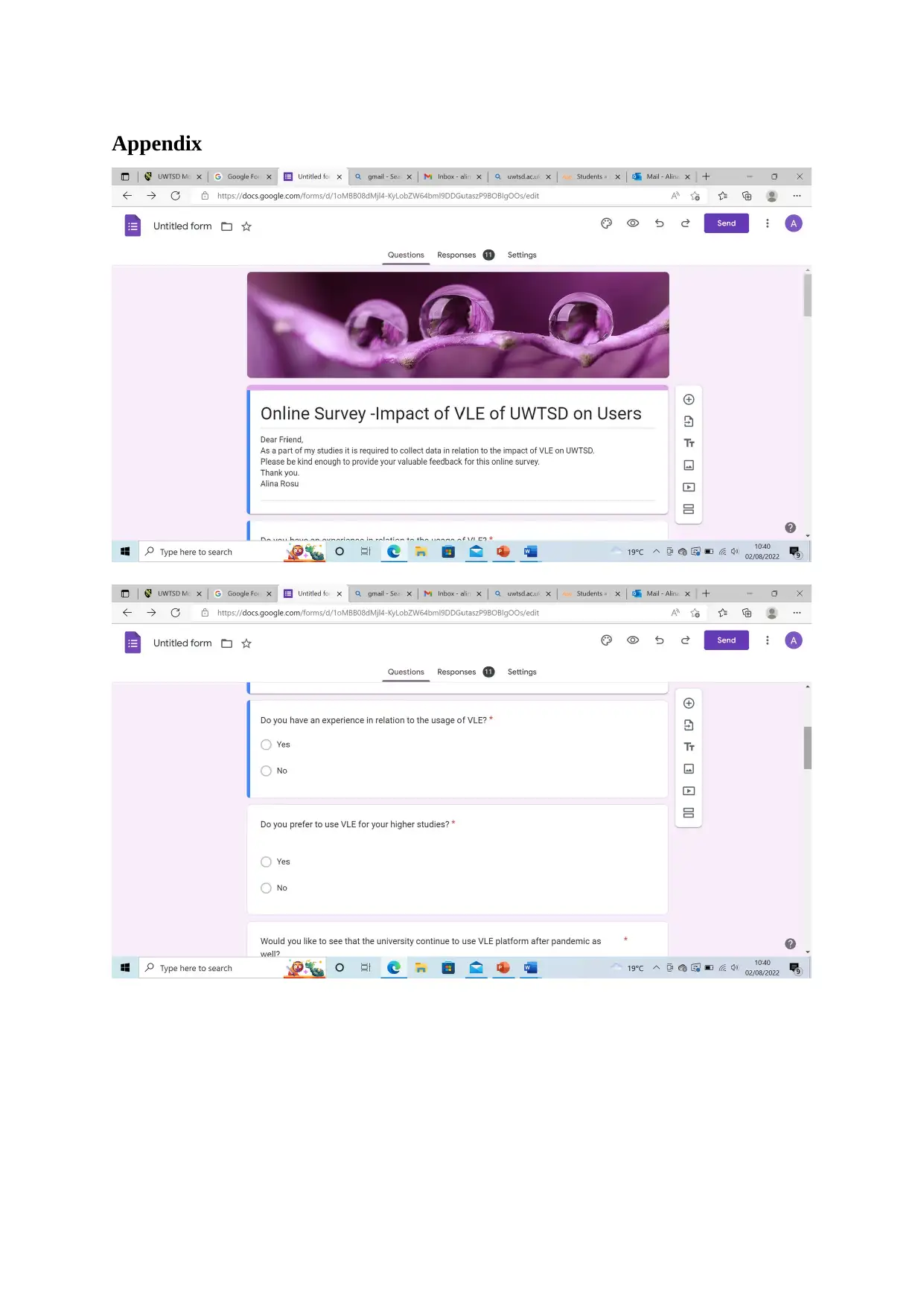
Appendix
⊘ This is a preview!⊘
Do you want full access?
Subscribe today to unlock all pages.

Trusted by 1+ million students worldwide
1 out of 20
Related Documents
Your All-in-One AI-Powered Toolkit for Academic Success.
+13062052269
info@desklib.com
Available 24*7 on WhatsApp / Email
![[object Object]](/_next/static/media/star-bottom.7253800d.svg)
Unlock your academic potential
Copyright © 2020–2025 A2Z Services. All Rights Reserved. Developed and managed by ZUCOL.



